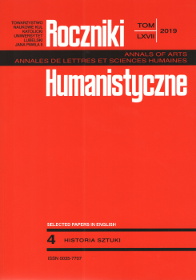From a Noble Substance to an Imitative Body. The Image and Meaning of Wax Figures in a Votive Offering
From a Noble Substance to an Imitative Body. The Image and Meaning of Wax Figures in a Votive Offering
Author(s): Jowita JaglaSubject(s): Fine Arts / Performing Arts, Visual Arts, History of Art
Published by: Towarzystwo Naukowe KUL & Katolicki Uniwersytet Lubelski Jana Pawła II
Keywords: wax; wax figure; votive offering; iconography; symbolism
Summary/Abstract: The Polish version of the article was published in Roczniki Humanistyczne vol. 62, issue 4 (2014). In a wealth of votive gifts, the wax ones undoubtedly deserve special attention. They were common as early as in the Middle Ages, and they were used until the 20th century. There was a variety of such votive offerings, starting with candles, through lumps of wax, and ending with full-scale wax figures that started being used as a votive gesture at the break of the 13th and 14th centuries in the north of Europe. In the 15th and 16th centuries this custom became popular among the wealthy German, Austrian and Italian noblemen. Making wax votive figures took a lot of skill so they were made by specially qualified artists (in Italy wax figures called Boti were produced by sculptors called Cerajuoli or Fallimagini). Religious orders collaborated with the artists-artisans, undertaking to supply wax, whereas the artisans prepared wooden frames, natural hair, glass eyes, paints, textiles and brocade. In the following centuries, the production of wax figures developed ever more dynamically, especially in the north of Europe, with less skilled wax modellers, artisans and gingerbread makers often being their producers. The latter ones mainly made smaller wax figures, cast or squeezed from two-part concave models (this type of items in their form and type reminded of figures made of gingerbread).Wax votive figures (especially of children aged three to 12) funded in the area of Upper and Lower Franconia (the Bamberg and Würzburg dioceses) from the mid-19th to the mid-20th century are a separate and rather unusual phenomenon. Popularity of this votive offering became stable about 1880, in the years 1900–1910 it reached its climax; and in the 1950s it came to an end. Franconian offerings were always constructed in a similar way: they had wax faces and hands (more rarely feet), and the other members were made of wood, metal and some other padding materials. Dolls were a dominating model for the production of these votes, and that is why, like dolls, they had wigs made of natural hair on their heads, glass eyes and open mouths. A very important role was played by clothing, in which figures were willingly dressed; they were children’s natural, real clothes (girls were often dressed in the First Communion dresses); moreover, the effigies had complete clothing, which means they had genuine underwear, tights, leather shoes. The figures were supplied with rosaries and bouquets held in their hands, and on the heads of girls there were garlands. The figures were put in cabinets and glass cases, sometimes with wallpaper on the back wall, and they had a longer text on the front glass with the name of the child, or possibly of its parents, and the time when the figure was offered.Despite the many features making the Franconian offering deposits different from votive figures from other regions, all these items are joined by a timeless and universal idea, in which—to quote H. Belting—“an artificial body has assumed the religious representation of a living body…”
Journal: Roczniki Humanistyczne
- Issue Year: 67/2019
- Issue No: 4SP
- Page Range: 59-79
- Page Count: 21
- Language: English

